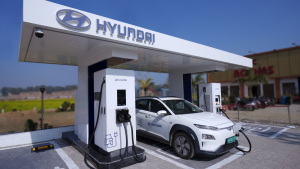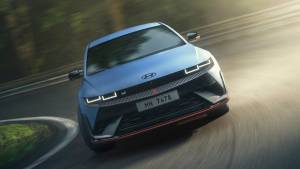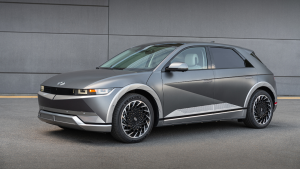2012 Hyundai Elantra in India first drive
-590px.jpg)
Sometimes being ahead of the times isn't healthy. Take for instance the TVS Centra, a motorcycle that had technologies that the masses never understood and cared for. It died, not an obvious death but certainly not a pleasing one. One of the reasons for the Centra not doing as well was the price that the technology demanded, it was a bit too much for the segment it wanted to attract. But this is not a story of a motorcycle.
In the early 2000's like the Centra, came the Hyundai Elantra, a car that too was well ahead of its time, offering technology and features that were thought to be more than what the segment demanded. In a word it was futuristic, perhaps too much because it too vanished without a trace. This despite the fact that it was sensibly priced, it's biggest USP was its value for money proposition and had so much kit that it made the tech shows look prehistoric. So where did the first generation Elantra go wrong?
There were a couple of reasons I surmise, first was the fact that the Elantra at the time was styled to distract and not attract. It's design especially that grille was a very hard dish to digest. The exterior design was a study in quirk-ism, and this happened at a time when Hyundai were still trying to find their feet in the world of automotive design. The interiors were just as confounding as the exteriors. Overall it was a car that did not subscribe to any particular design language and it all felt like gibberish. Hyundai had a tough time keeping interest alive in the product in a market where styling was getting to be one of the most important selling points.
The second and more important reason I gather has to do with Hyundai being Korean. At the time the entry luxury segment was dominated by the Japanese thanks to the Toyota Corolla and the Skoda Octavia coveted for being the most affordable European car with a very competent power train. Owning something that was made in Korea did not seem like a luxury lifestyle choice at all especially since Hyundai was seen as a provider for the masses not classes.
In the last few years things have changed, the Koreans are seen as a dominant player across the globe and their sense of design, aesthetics and technology are highly coveted by everyone. The new Elantra is a critical part of that change and to say that Hyundai is purely for the masses would be gross negligence. The Elantra unfortunately has been absent from a segment that now has half a dozen other cars to choose from. What makes it interesting is its freshness, but to hold that interest and convert it to box office numbers it needs substance. Does the Elantra have that substance?
On the styling front the Elantra has moved leagues ahead of what it was. It's a classic tale of ugly duckling to swan, to the extent that I doubt you'd find a better looking car in the entry-level luxury segment. It is probably the best expression there is of Hyundai's fluidic design language, better than both the Sonata and the Verna. Of course a lot of comments have been made on just how similar it looks to the Verna but that is bound to happen within a family, look at Audi, VW, Mercedes, etc. However look a little closer and you will begin to notice the differences, subtle though they may be. The headlamps for instance aren't the same, while in both cars they appear aesthetically stretched over the hood and fenders the Elantra's set are sleeker, shapely and longer. Even the tail lamps are longer sleeker units that sweep from the boot onto the rear fenders sharply. The profile also shows a very swoopy silhouette with the roofline sharply falling towards the rear. In fact the acutely raked windshield areas at both the front and back provide large glass areas that make the overall car look sporty yet spacious within.
The Elantra's proportions may not seem too large either, yet at 4.53 metres in length it is nearly as long as the Skoda Laura and a width of 1.77 metres places it as one of the widest in the segment. Its wheelbase to track ratio has very stable proportions, and the stance the Elantra occupies adds to that stability. The overhangs at both ends may turn out to be a bit of a problem since they appear to be long on a car that also sits quite close to the ground.
Inside the cabin the Elantra turns out to be a very spacious car, which you don't get a sense of from the outside. But before that ingress and egress will be an issue, hampered by the sloping roofline, the low door openings and the low seats especially for the passengers sitting at the rear. What resurrects it are the large doors which open wide and the ample knee room for the rear passengers, it simplifies the task of having to manoeuvre into your seat as opposed to just dropping onto them.
The cabin then, as I mentioned is spacious with enough room to accommodate five passengers comfortably. Thanks to the generous rear knee room and the transmission tunnel not intruding onto the floor space, a third passenger at the rear has enough space to wedge in comfortably. Even at the front there is enough space especially within the foot well, and despite a rather wide transmission tunnel there aren't any edges to bruise your knees.
The high points within this cabin are the fit, finish, attention to detail and reasonably upmarket material quality. This is a neatly finished cabin and though the dashboard looks a bit busy it also feels quite premium. I quite like the impression the dashboard provides of flowing into the centre stack and then continuing languidly onto the transmission tunnel separating the driver from the front passenger.
What I don't like are the layers, the position of the centre air-con vents and the three screens. If you look around the centre console area there are just too many layers of varying colours vying for attention. This could have been toned down to just two to make the visual a bit subtle and more pleasing. The air con vents could have been positioned higher on the blank panels right next to the audio system which would have perhaps improved cooling efficiency. And finally the three display screens, one that displays the time, the next for the audio system and the lowest one for the climate control, couldn't they have been integrated into one single unit? Each of those screens turns a bright neon blue after dark and are very distracting.
Moving on to the engines, Hyundai will offer both petrol and diesel options, with both manual and automatic transmission choices. I just hope that Hyundai are well prepared for the demand for the diesel engine with the 6-speed manual transmission. This diesel is the same CRDi engine used in the Verna with the same power and torque ratings. So you get a 1582cc DOHC common rail variable geometry turbocharged diesel that makes 128PS of max power and 260Nm of max torque. Before the questions can be raised yes, this engine feels better in the Verna because it is lighter than the Elantra. Does the engine feel strained under the weight of the Elantra? No, it does not. This engine is refined and smooth and power delivery is linear though it does not feel as punchy as in the Verna. It picks up easily and I saw nearly 190kmph on the speedo before I had to back off the throttle.
I also sampled the manual and automatic transmissions and while the manual felt a bit sticky it was nonetheless precise. The ratios are however spaced far apart and despite the 260Nm of torque it takes a mighty long time for the rev needle to hit the 4600rpm red line. The same ratios can be found in the automatic however this particular gearbox sounds noisy and whiny, almost like a CVT as it climbs up to its 4400rpm shift point. Our recommendation is to go with the manual.
The suspension and chassis uses all the conventional bits that you'd get in any contemporary car. The three-box monocoque resides atop a McPherson strut at the front and a coupled torsion beam axle at the rear. This suspension setup is tuned for ride comfort and it works impressively ironing out all bumps and potholes. There is a lot of body roll, given the soft nature of this suspension but despite me pushing her she felt understeery but never entirely out of bounds.
The steering was what impressed me the most as it's got just the right amount of weight to give it the stability and balance at motorway speeds. On the Verna and the i20 for instance the steering feels just too light at all speeds make driving either of them a hair raising experience once speeds climb north. That said the steering is entirely desensitized and you get no feedback at all, but at the least it's not weightless.
The Elantra is also assisted by several safety systems like ESP and vehicle stability management. You get six airbags as standard equipment and the rest of the safety paraphernalia as well such as ABS, hill start assist, etc.
Previously the Elantra was also known for possessing a rich feature list and that trend continues. You still get an awesome list of equipment which among several other things also includes cooled seats (driver and passenger) which incidentally don't even feature on my long term E-Class, Bluetooth connectivity, auto headlamps and a reverse camera with parking assistance.
On the whole the Elantra is a remarkable car, a much improved version of a car that did not get the attention it deserved before. We expect it to be priced in the Rs 10-14 lakh price bracket where it will compete against cars such as the Corolla, the Cruze and the Laura. But we also expect Hyundai to surprise the market. It's a second chance for a stellar product to shine!
Starts Rs 17.6 Lakhs
1493cc
Automatic
115
250
-NA-
Starts Rs 25.99 Lakhs
1984cc
Automatic
190
320
15.81 Kmpl














